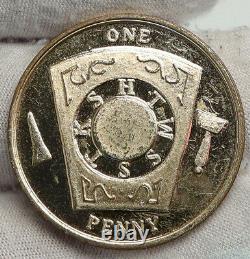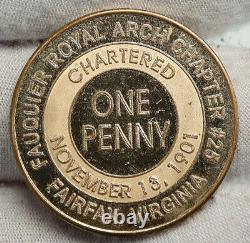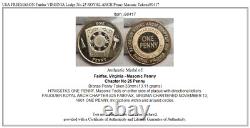USA FREEMASON Fairfax VIRGINIA Lodge No 25 ROYAL ARCH Penny Masonic Token i90417




Item: i90417 Authentic Medal of. Fairfax, Virginia - Masonic Penny Chapter No 25 Penny Bronze Penny Token 33mm (13.11 grams) HTWSSTKS ONE PENNY, Masonic Tools on either side of plaque with directional letters. FAUOUIER ROYAL ARCH CHAPTER #25 FAIRFAX, VIRGINIA CHARTERED NOVEMBER 13, 1901 ONE PENNY, Inscriptions within and around circles. Historical Sketch of Henry Lodge No. This historical sketch was produced for the 125th Anniversary Celebration of Henry Lodge No. Masonry in Fairfax, Virginia began on May 30, 1849 when a dispensation was given by the Grand Master of Masons in Virginia to form a Lodge at the Fairfax Courthouse. On December 12, 1849 a charter was issued to Henry Masonic Lodge No. This Lodge was in existence until December of 1855.
Request for the Formation of a New Lodge Approved in 1869. On March 4, 1869 a petition was read in Andrew Jackson Lodge No.
120, requesting approval for the formation of a new Lodge at the Fairfax Courthouse. A motion was made and approved and on March 5, 1869 the District Deputy Grand Master gave his approval. In the original petition the name of the Lodge was to be Worthington, after its charter Master, John Y. Worthington, but the name Worthington was crossed out and the name Henry substituted above it. A note on the outside of the petition explains the substitution.The name of Henry is substituted for Worthington as we have already a set of Jewels belonging to a private individual marked Henry Lodge. Henry Lodge Chartered on December 15, 1869. On March 15, 1869 a regular communication of Henry Lodge, under dispensation, was held at its Hall at the Fairfax Courthouse.
On December 15, 1869 Henry Lodge was given the number 57 and chartered by the Grand Lodge of Virginia. The number 57 previously had been held by George Washington Lodge in Berryville, Clark County, Virginia. There was a very prominent "Henry" connected with the Lodge from its earliest years. One of the petitioners of the new Lodge was a Henry W.
Thomas, who had been a member, although not a founding member, of Henry Lodge No. Thomas was born October 20, 1812.
He became a lawyer, and then Commonwealth's Attorney in 1838 at the age of 26. He was a member of the Virginia House of Delegates from 1841-42 and again from 1847-48. He continued his legislative service to the Commonwealth in the Virginia Senate, serving from 1850-63 and from 1871-75. He also was a Judge on the Ninth Circuit Court and served as Lt. He died at his home in Fairfax a bit shy of his 78th Birthday on June 23, 1890.
Tradition has it that Brother Thomas would not lend his surname to the Lodge but consented to the use of Henry and that the Lodge was named after this good brother. A search of the old records of the Lodge does not support this story and we have not found any written record of a "Henry" for whom the Lodge was named. Meeting Places for Henry Lodge. The minutes make mention that the Lodge rented a building from a Mrs.Stephenson from late 1869 to the end of December 1876. Then, from January 1877 through the summer of 1885, the Lodge rented the Hall of Providence Lodge No. 3, Independent Order of Good Templars, a temperance society. From 1885 to June 1899, the Lodge Hall was in space rented from a Mr.
Hawxhurst whose store and post office was directly across Route 123 from the Courthouse. This spot was recently the location of a gas station owned by Brother Munday. Hawxhurst's building burned to the ground sometime before June 24, 1899, and the Lodge then met in the jury room of the Courthouse until July 1900. July 1900 also saw the completion of the Fairfax Town Hall, built by Brother Joseph E.
In a deed dated July 30, 1900 and recorded October 22,1900, Joseph E. Willard and his wife, Belle L. Wyatt Willard, conveyed to the trustees of Fairfax Town Hall, a lot of land, together with the Town Hall, but conveyance included a number of trusts. The first trust required the trustees to permit the Masonic organization of Henry Lodge No. 57 to hold its regular and special meetings in the upper room of said Hall and to have exclusive use of the small northeast room on the second floor of said Hall. Construction of New Lodge Hall Planned. By the early 1960's the lack of parking, the poor condition of the facilities and problems with the trustees concerning the use of the Hall prompted the Lodge to consider moving once again. On October 24, 1968 the Lodge bought lots 2, 3, 4, and 5 of Section 4 of Fairfax Acres on which to erect a new Lodge Hall. Permit Issued in 1970 for New Building. Contributions to the building fund continued and on September 4, 1970 the note was paid off and canceled giving the Lodge clear title to its property. Cornerstone Laid on September 5, 1970. On the next day, September 5, 1970, the cornerstone was laid with appropriate ceremony by the District Deputy Grand Master, Rt. Maley, with the oration given most eloquently by Rt. The minutes of the September 5, 1970 called communication record the list of articles placed in the cornerstone to include a copy of the Lodge charter, a copy of the History of Henry Lodge presented on its 100th anniversary on December 15, 1969, two "One Hundredth Anniversary Medallions" and a set of U. Building Ready for Occupancy on June 8, 1971. Finally, on June 8, 1971, well into its 101st year of existence, the building was ready for occupancy and Henry Lodge held its first meeting in its new temple at 10503 Oak Place in Fairfax, Virginia and, at that meeting, raised Brother Walter Leyton Stephons to the degree of Master Mason. Henry Lodge Joins District No. During the first century of continuous existence, Henry Lodge No. 57 was in three different Masonic Districts. From 1869 to 1913 the Lodge was in District 1. A portion of our records was lost but in 1919 Henry Lodge was in District 54. In 1936 Henry Lodge requested a transfer from District 54 to District 58.It was suggested that Henry Lodge was a country or rural Lodge unlike Columbia and Cherrydale Lodges that were considered to be "city" Lodges and also that qualified members of Henry Lodge were being passed over for the Office of District Deputy Grand Master. The request was granted in February 1937 when Henry joined Acacia, Herndon, Manasseh and Drinkard (Haymarket) Lodges as a member of District 58.
At the end of its first century, Henry Lodge Masons were as active, proficient and sophisticated as any "city" Masons, but, with traffic and congestion being what they were in Fairfax, the good old days of being considered a country or rural Lodge seem regretfully, gone forever. Henry Lodge Celebrates 125 Years of Continuous Service to the City of Fairfax. On October 8, 1994, Henry Lodge is celebrating 125 years of continuous service to the city of Fairfax and to the Commonwealth of Virginia. A reenactment of the cornerstone laying will be performed.A time capsule will be made for the occasion and its "burial" is being witnessed by a sizable throng of members and friends. Five Lodges in District No. 58 to Merge with District No.
In November of 1994, Henry Lodge will become a part of District No. The decision to merge the 5 lodges of District No. 4 was made during the term of Most Worshipful Werner Herman Morlock. The Grand Lodges proceedings in Roanoke on November 14,1994, will finalize the action and District No.
The 5 Lodges join Mt. 133 Lodge in Warrenton, Virginia to make the "new" District No. The Ancient and Accepted Scottish Rite of Freemasonry the Northern Masonic Jurisdiction in the United States often omits the. While the English Constitution in the United Kingdom omits the.
, commonly known as simply the Scottish Rite (or, in England and Australia, as the Rose Croix although this is only one of its degrees), is one of several Rites of Freemasonry. A Rite is a progressive series of degrees conferred by various Masonic organizations or bodies, each of which operates under the control of its own central authority.In the Scottish Rite the central authority is called a Supreme Council. The Scottish Rite is one of the appendant bodies of Freemasonry that a Master Mason may join for further exposure to the principles of Freemasonry.
It is also concordant, in that some of its degrees relate to the degrees of Symbolic (Craft) Freemasonry. In England and some other countries, while the Scottish Rite is not accorded official recognition by the Grand Lodge, only a recognised Freemason may join and there is no prohibition against his doing so. In the United States, however, the Scottish Rite is officially recognized by Grand Lodges as an extension of the degrees of Freemasonry. The Scottish Rite builds upon the ethical teachings and philosophy offered in the Craft (or Blue) Lodge, through dramatic presentation of the individual degrees. Freemasonry or Masonry consists of fraternal organisations that trace their origins to the local fraternities of stonemasons, which from the end of the fourteenth century regulated the qualifications of stonemasons and their interaction with authorities and clients. The degrees of freemasonry retain the three grades of medieval craft guilds, those of Apprentice, Journeyman or fellow (now called Fellowcraft), and Master Mason. These are the degrees offered by Craft (or Blue Lodge) Freemasonry. Members of these organisations are known as Freemasons or Masons. There are additional degrees, which vary with locality and jurisdiction, and are usually administered by different bodies than the craft degrees. The basic, local organisational unit of Freemasonry is the Lodge.The Lodges are usually supervised and governed at the regional level (usually coterminous with either a state, province, or national border) by a Grand Lodge or Grand Orient. There is no international, worldwide Grand Lodge that supervises all of Freemasonry; each Grand Lodge is independent, and they do not necessarily recognise each other as being legitimate. Modern Freemasonry broadly consists of two main recognition groups. Regular Freemasonry insists that a volume of scripture is open in a working lodge, that every member profess belief in a Deity, that no women are admitted, and that the discussion of religion and politics is banned.
Continental Freemasonry is now the general term for the "liberal" jurisdictions who have removed some, or all, of these restrictions. The Hudson River is a 315-mile (507 km) river that flows from north to south primarily through eastern New York in the United States. The river originates in the Adirondack Mountains of Upstate New York, flows southward through the Hudson Valley to the Upper New York Bay between New York City and Jersey City.
It eventually drains into the Atlantic Ocean at New York Harbor. The river serves as a political boundary between the states of New Jersey and New York at its southern end. Further north, it marks local boundaries between several New York counties. The lower half of the river is a tidal estuary, deeper than the body of water into which it flows, occupying the Hudson Fjord, an inlet which formed during the most recent period of North American glaciation, estimated at 26,000 to 13,300 years ago.Tidal waters influence the Hudson's flow from as far north as the city of Troy. The river is named after Henry Hudson, an Englishman sailing for the Dutch East India Company, who explored it in 1609, and after whom Hudson Bay in Canada is also named.
It had previously been observed by Italian explorer Giovanni da Verrazzano sailing for King Francis I of France in 1524, as he became the first European known to have entered the Upper New York Bay, but he considered the river to be an estuary. The Dutch called the river the North River - with the Delaware River called the South River - and it formed the spine of the Dutch colony of New Netherland. Settlements of the colony clustered around the Hudson, and its strategic importance as the gateway to the American interior led to years of competition between the English and the Dutch over control of the river and colony. During the eighteenth century, the river valley and its inhabitants were the subject and inspiration of Washington Irving, the first internationally acclaimed American author.In the nineteenth century, the area inspired the Hudson River School of landscape painting, an American pastoral style, as well as the concepts of environmentalism and wilderness. The Hudson was also the eastern outlet for the Erie Canal, which, when completed in 1825, became an important transportation artery for the early-19th-century United States. World-renowned expert numismatist, enthusiast, author and dealer in authentic ancient Greek, ancient Roman, ancient Byzantine, world coins & more. Ilya Zlobin is an independent individual who has a passion for coin collecting, research and understanding the importance of the historical context and significance all coins and objects represent.
Send me a message about this and I can update your invoice should you want this method. Getting your order to you, quickly and securely is a top priority and is taken seriously here. Great care is taken in packaging and mailing every item securely and quickly. What is a certificate of authenticity and what guarantees do you give that the item is authentic? You will be very happy with what you get with the COA; a professional presentation of the coin, with all of the relevant information and a picture of the coin you saw in the listing. Additionally, the coin is inside it's own protective coin flip (holder), with a 2x2 inch description of the coin matching the individual number on the COA.Whether your goal is to collect or give the item as a gift, coins presented like this could be more prized and valued higher than items that were not given such care and attention to. When should I leave feedback? Please don't leave any negative feedbacks, as it happens sometimes that people rush to leave feedback before letting sufficient time for their order to arrive. The matter of fact is that any issues can be resolved, as reputation is most important to me. My goal is to provide superior products and quality of service.
How and where do I learn more about collecting ancient coins? Visit the Guide on How to Use My Store.
For on an overview about using my store, with additional information and links to all other parts of my store which may include educational information on topics you are looking for. This item is in the category "Coins & Paper Money\Exonumia\Medals". The seller is "highrating_lowprice" and is located in this country: US. This item can be shipped worldwide.
- Denomination: Penny
- Country/Region of Manufacture: United States
- Type: Medal

